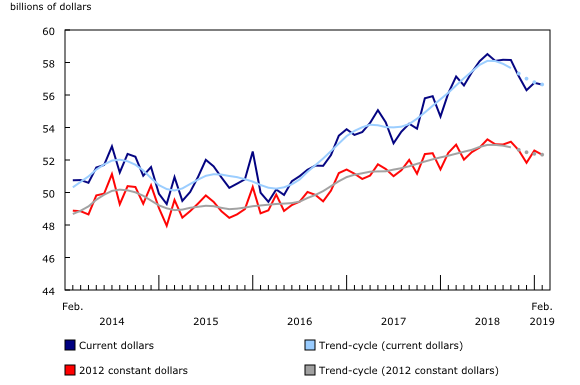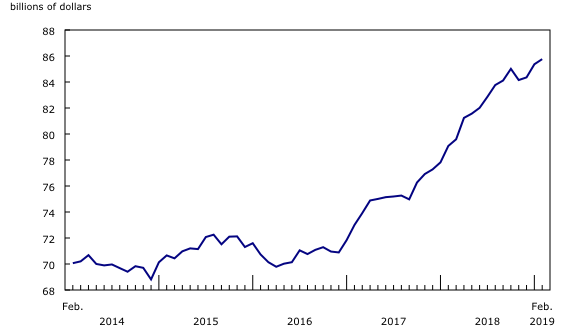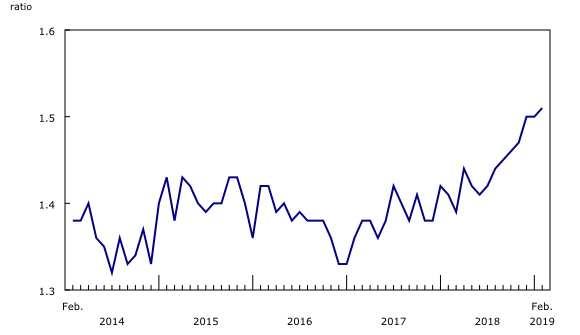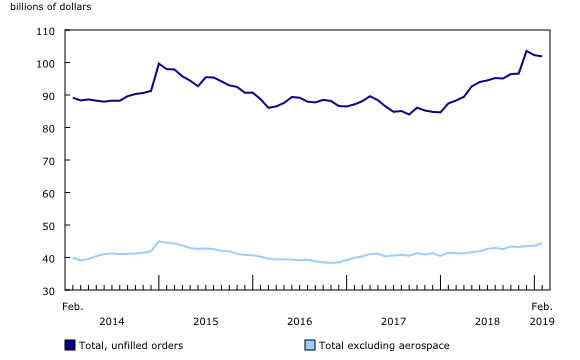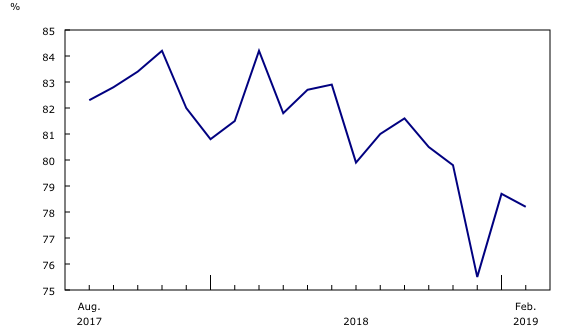Monthly Survey of Manufacturing, February 2019
Archived Content
Information identified as archived is provided for reference, research or recordkeeping purposes. It is not subject to the Government of Canada Web Standards and has not been altered or updated since it was archived. Please "contact us" to request a format other than those available.
Released: 2019-04-16
Manufacturing sales edged down 0.2% in February to $56.6 billion, following a 0.8% increase in January.
The largest declines were in the motor vehicle assembly and wood products industries. However, these decreases were largely offset by gains in the petroleum and coal product, paper and machinery industries.
Excluding motor vehicle sales, manufacturing sales were up 0.2%.
Sales were down in 15 of 21 industries, representing 65.9% of the Canadian manufacturing sector. Sales of durable goods declined 1.4% to $30.1 billion, while sales of non-durable goods rose 1.2% to $26.6 billion.
In volume terms, manufacturing sales decreased 0.5% in February.
Motor vehicles and wood products sales decline
Sales in the motor vehicle assembly industry were down 4.4% to $4.9 billion in February, mostly attributable to fewer vehicles sold.
Wood product sales declined 5.9% to $2.5 billion as a result of widespread decreases in the industry. Several wood product manufacturers indicated that they received lower orders as demand and housing starts in Canada and United States declined in February.
Partially offsetting these declines were increases in the petroleum and coal product industry, as sales rose for the second consecutive month, up 7.1% to $5.7 billion in February. The increase reflected higher prices as well as higher volumes, as several refineries ramped up production. In constant dollars, sales of petroleum and coal products rose 3.7% in February.
Sales also increased in the paper (+6.8%), machinery (+3.3%) and plastic and rubber product (+2.4%) industries.
Sales down in six provinces
Sales were down in six provinces in February, led by Ontario and Saskatchewan. This was mostly offset by higher sales in Quebec and New Brunswick.
Following a 0.9% gain in January, sales in Ontario declined 1.7% to $25.8 billion in February, mainly reflecting lower sales of transportation equipment (-4.5%). Motor vehicle assembly decreased 4.7%, partly due to temporary plant shutdowns and retooling. The aerospace product and parts industry declined 26.7% following a 38.6% gain in January.
Sales in Saskatchewan decreased 6.3% to $1.4 billion. Durable goods declined 15.8% while non-durable goods were down 2.4%.
In Quebec, sales rose 3.7% to $14.2 billion, with 14 of 21 industries increasing. The aerospace product and parts industry rose 22.1%, following a 27.0% decline in January. Sales also increased in the petroleum and coal product, paper and machinery industries.
Sales in New Brunswick increased 7.7% following a 16.1% gain in January. Sales of non-durable goods were the main contributor to the overall gain.
Inventory levels increase
Inventory levels increased for the third consecutive month, rising 0.5% to $85.8 billion in February. Inventories were up in 9 of 21 industries, with the largest increases in the primary metal (+1.8%), petroleum and coal product (+3.1%) and machinery (+1.4%) industries. These increases were partially offset by a decline in wood, motor vehicle and food inventories.
The inventory-to-sales ratio increased from 1.50 in January to 1.51 in February. This ratio measures the time, in months, that would be required to exhaust inventories if sales were to continue at their current rates.
Unfilled orders decline
Unfilled orders were down 0.4% to $101.9 billion in February, following a 1.3% decline in January. The decrease in February mainly reflected lower unfilled orders in the aerospace product and parts industry (-2.1%). This was partially offset by higher unfilled orders in ship and boat building and computer and electric products industries.
New orders were up 1.5% to $56.3 billion, mainly as a result of higher orders of transportation equipment (+7.1%).
Capacity utilization rate
The unadjusted capacity utilization rate for the manufacturing sector decreased from 78.7% in January to 78.2% in February. While declines were widespread, the chemical industry had the largest decrease in capacity utilization rate, falling from 84.7% in January to 81.8% in February.
The capacity utilization rate for the petroleum and coal product industry increased for the second consecutive month, rising 1.2 percentage points to 85.2% in February, reflecting a gradual ramp up of production at several refineries.
Sustainable Development Goals
On January 1, 2016, the world officially began implementation of the 2030 Agenda for Sustainable Development—the United Nations' transformative plan of action that addresses urgent global challenges over the next 15 years. The plan is based on 17 specific sustainable development goals.
The Monthly Survey of Manufacturing is an example of how Statistics Canada supports the reporting on the Global Goals for Sustainable Development. This release will be used in helping to measure the following goal:

Note to readers
Monthly data in this release are seasonally adjusted and are expressed in current dollars unless otherwise specified.
For information on seasonal adjustment, see Seasonally adjusted data – Frequently asked questions. For information on trend-cycle data, see Trend-cycle estimates – Frequently asked questions.
Non-durable goods industries include food, beverage and tobacco products, textile mills, textile product mills, clothing, leather and allied products, paper, printing and related support activities, petroleum and coal products, chemicals, and plastics and rubber products.
Durable goods industries include wood products, non-metallic mineral products, primary metals, fabricated metal products, machinery, computer and electronic products, electrical equipment, appliances and components, transportation equipment, furniture and related products, and miscellaneous manufacturing.
Production-based industries
For the aerospace and shipbuilding industries, the value of production is used instead of the value of sales of goods manufactured. The value of production is calculated by adjusting monthly sales of goods manufactured by the monthly change in inventories of goods in process and finished products manufactured. The value of production is used because of the extended period of time that it normally takes to manufacture products in these industries.
Unfilled orders are a stock of orders that will contribute to future sales assuming that the orders are not cancelled.
New orders are those received, whether sold in the current month or not. New orders are measured as the sum of sales for the current month plus the change in unfilled orders from the previous month to the current month.
Manufacturers reporting sales, inventories and unfilled orders in US dollars
Some Canadian manufacturers report sales, inventories and unfilled orders in US dollars. These data are then converted to Canadian dollars as part of the data production cycle.
For sales, based on the assumption that they occur throughout the month, the average monthly exchange rate for the reference month established by the Bank of Canada is used for the conversion. The monthly average exchange rate is available in table 33-10-0163-01. Inventories and unfilled orders are reported at the end of the reference period. For most respondents, the noon spot exchange rate on the last working day of the month is used for the conversion of these variables.
However, some manufacturers choose to report their data as of a day other than the last day of the month. In these instances, the daily average exchange rate on the day selected by the respondent is used. Note that because of exchange rate fluctuations, the daily average exchange rate on the day selected by the respondent can differ from both the exchange rate on the last working day of the month and the monthly average exchange rate. Daily average exchange rate data are available in table 33-10-0036-01.
Revision policy
Each month, the Monthly Survey of Manufacturing releases preliminary data for the reference month and revised data for the three previous months. Revisions are made to reflect new information provided by respondents and updates to administrative data.
Once a year, a revision project is undertaken to revise multiple years of data. Statistics Canada will release revised monthly manufacturing data on May 16, in accordance with standard practices. Sales of goods manufactured, inventories and orders in current dollars will be revised back to January 2013 for unadjusted data and to January 2011 for seasonally adjusted and constant dollar data.
Real-time data tables
Real-time data tables 16-10-0118-01, 16-10-0119-01, 16-10-0014-01 and 16-10-0015-01 will be updated on April 25.
Next release
Data from the Monthly Survey of Manufacturing for March will be released on May 16.
Contact information
For more information, contact us (toll-free 1-800-263-1136; 514-283-8300; STATCAN.infostats-infostats.STATCAN@canada.ca) or Media Relations (613-951-4636; STATCAN.mediahotline-ligneinfomedias.STATCAN@canada.ca).
To enquire about the concepts, methods or data quality of this release, contact Bechir Oueriemmi (613-951-7938; bechir.oueriemmi@canada.ca), Mining, Manufacturing and Wholesale Trade Division.
- Date modified:




